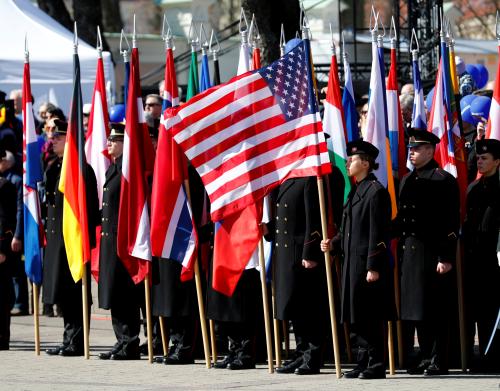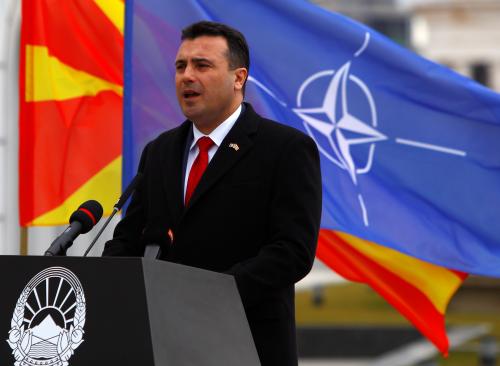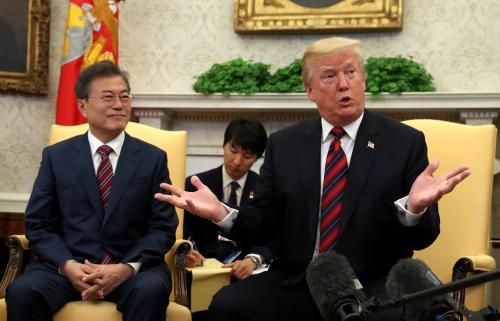The Vitals
The word “ally” has been in the news a lot in recent months. Members of Congress have criticized President Trump for abandoning our Kurdish “allies” in Northern Syria and complained that the president was undermining our “ally” Ukraine. Meanwhile, President Trump reiterated his belief that “our allies take advantage of us far greater than our enemies,” and in advance of the December NATO Leaders Meeting, the United States announced cutbacks in its support for common funding at the headquarters. Americans have frequently been told that allies matter, but what exactly does it mean to be a U.S. “ally”? And why are relationships deemed so vital to American security frequently so contentious?
-
America’s alliances in Asia and Europe have formed the backbone of what has become known as the “liberal international order.” Over the past 70 years, this order has helped protect American interests and values.
-
Not every country that is referred to as an “ally” meets the formal definition of a country that America has said it is willing to defend in case of attack.
-
The question of how to create “fair” burden-sharing arrangements has been a long-standing issue in U.S. alliances, but on balance, the United States has reaped enormous benefits from these relationships.
A Closer Look
Where did U.S. alliances come from?
In his farewell
address to the nation, George Washington argued that the benefits
of this country’s location far from other centers of power, with oceans on
either side, meant that “It is our true policy to steer clear of permanent
alliances with any portion of the foreign world.”
Following World War II, however, American leaders recognized that to keep the country safe at home, the U.S. would need to manage threats abroad—before they arrived at the American homeland. The result was the decision to establish a set of formal treaty alliances that would create a collective defensive effort to contain Communist expansionism. The U.S. created the North Atlantic Treaty Organization (NATO) with Canada and Western Europe in 1949. In 1951, it signed a Security Treaty with Japan as well as one with Australia and New Zealand (ANZUS), followed in 1953, by a Mutual Defense Treaty with the Republic of Korea (ROK), all of which continue to this day.
The theory behind establishing the U.S. alliance system was that building the capabilities of like-minded states and creating a network of collective defense arrangements would more effectively and efficiently protect America’s global interests. And it has. Over the past 70 years, America’s alliances in Asia and Europe have formed the backbone of what has become known as the “liberal international order,” a U.S.-led system focusing on promoting democracy, market economies, the rule of law, and respect for human rights.
What is a treaty ally—and what isn’t?
Not every country that is referred to as an “ally” meets the
formal definition of a country that America has said it is willing to defend in
case of attack. The U.S. has close partnerships, for example, with Israel and
Saudi Arabia, but those countries are not formal allies. While abandoning the
Kurds in Northern Syria raises moral and strategic questions, there is no
formal alliance relationship with them. Similarly, what makes Ukraine different
from a country like Poland or Estonia is that while it has long received
American support, the U.S. has made no treaty commitment to its defense and,
therefore, it is not formally an ally.
The core feature of U.S. alliances is their shared
commitment to respond collectively to armed attacks, though different U.S.
treaties contain slight variations in how they articulate this requirement. The
most forceful of these commitments is contained in NATO’s Article
V, which states: “an armed attack against one or more [member
countries] in Europe or North America shall be considered an attack against
them all.” Although this commitment was designed to
give West Europeans confidence that the U.S. would come to their aid if
attacked by the Soviet Union, Article V has been invoked only one time in the
70-year history of NATO: on September 12, 2001 by the non-American allies after
the 9/11 terrorist attacks on the U.S.
Do U.S. allies pay their fair share?
The question of how to create
“fair” burden-sharing arrangements has been a long-standing issue in U.S.
alliance relationships. U.S. presidents since Dwight Eisenhower
have complained that NATO allies were not doing enough to contribute to the common
defense. Similarly, the Nixon administration urged Asian allies to play a
larger role in their own defense as early as the late 1960s. As U.S. allies
grew both more economically powerful and more democratic in the 1970s and
1980s, U.S. policymakers pushed more forcefully for partners to shoulder a
larger share of the costs of collective defense.
Debates about “burden sharing” tend to focus on two main issues: allied defense budgets and the cost of hosting U.S. forces overseas. Allied defense budgets have waxed and waned—as have U.S. defense budgets—but it’s true that in general, the U.S. has spent a higher proportion of GDP on defense than many allies. In the past decade, however, renewed concerns about Chinese and Russia aggression—as well as calls from both the Obama and Trump administrations for greater allied defense spending—have led many U.S. allies to increase defense spending. In Asia, Australia, Japan, and South Korea have all announced plans for significant new defense investments, much of which includes purchases of U.S. weapons systems. In Europe, following Russia’s invasion of Ukraine in 2014, NATO members agreed to aspire to spend at least 2% of their GDP on defense by 2024. Only four non-U.S. NATO members had met that goal by 2017, leading to bitter complaints from President Trump. But the most recent data released by NATO show steady growth in spending, with eight countries now meeting the 2% target. NATO members also recently agreed to a new cost-sharing formula that will result in Germany and the U.S. paying an equal share—approximately 16%—of NATO’s operating costs beginning in 2021.
Another focus of “burden sharing” discussions has been the
cost of maintaining U.S. forces overseas. The largest concentration of U.S. troops
are now in Japan (~50,000), Germany (~35,000), and the Republic of Korea (~28,000).
President Trump has criticized the costs of these bases, arguing that allies should “either pay the
United States for its great military protection, or protect themselves.”
However, America does not deploy its forces as mercenaries for hire, simply to
defend the territory of U.S. allies. America’s global defense network allows it
to more quickly and effectively address a range of global requirements,
including protecting American
citizens, preventing piracy, deterring
violent
extremism, and preventing countries like North
Korea and Iran from trafficking illicit weapons. U.S. allies work
alongside the U.S. in all of these efforts.
America’s allies also defray significant portions of the cost of its overseas military facilities, spending billions of dollars to offset costs the U.S. would otherwise bear alone. Allies contribute to the cost of U.S. facilities both directly and indirectly, through cash payments; in-kind payments such as tax and fee waivers; covering construction costs for U.S. housing and training facilities; and the rent-free provision of valuable real estate to U.S. forces. For example, Japan and South Korea spend almost $2 billion and $1 billion dollars per year, respectively, on host nation support to the United States. South Korea and Japan have also shouldered significant portions of the spending for some of the largest U.S. military construction projects in decades, each paying billions of dollars to support new U.S. facilities in Guam and on the Korean peninsula.
What does the United States get from these arrangements?
While the formal defense
requirements of U.S. treaty alliances are relatively narrow, the security
benefits it gets from these relationships is significant. On a daily basis, the
U.S. and its allies share intelligence, train and exercise alongside each
other, and operate common weapons systems, creating combined capabilities that
far exceed any force the U.S. could wield on its own. America’s allies have
fought alongside the U.S. in every significant military conflict since World
War II. In Afghanistan alone, NATO allies have lost around 1,000 service members in support of coalition operations. U.S. allies also form the backbone
of support for the global coalition to counter the Islamic State, which now
numbers 81 partner nations.
The benefits the U.S. accrues from
its alliances stretch far beyond the military domain. America’s allies provide support
for U.S. political priorities—such as sanctioning Iran and North Korea’s
illicit weapons programs and providing financial support for reconstruction
efforts in Iraq and Afghanistan. Allies such as Japan are working together with
the U.S. to advance fair and transparent international standards on issues such
as digital governance and cyber security. And within the G-7, U.S. allies have
coordinated to address issues ranging from the global refugee crises, to international health
standards, and education for women and children. Put simply, the past 70 years
of American international leadership would not have been possible without the
support of U.S. allies.
Can we imagine a world without our allies?
America’s alliances are under great strain due to President
Trump’s repeated assertions that the U.S. has borne too great a burden in
maintaining them. While it is appropriate for U.S. leaders to engage in
discussions about cost-sharing and responsibilities with alliance partners, the
president’s rhetoric overlooks the enormous military, political, and financial
advantages U.S. alliances have provided.
One need only briefly consider what the past 70 years might
have looked like without America’s allies. Could the U.S. have won the Cold War
without the NATO alliance? What costs would the U.S. have borne in Iraq, Afghanistan,
and Syria without allies by its side? Today, as the U.S. works to address growing
authoritarianism and threats to the rule of law, the U.S. alliance network is
the strongest advantage it has at its disposal—which is why Congress and the
American public have long provided strong bipartisan support for maintaining
these ties.
The Brookings Institution is committed to quality, independence, and impact.
We are supported by a diverse array of funders. In line with our values and policies, each Brookings publication represents the sole views of its author(s).











Commentary
Who are America’s allies and are they paying their fair share of defense?
December 17, 2019